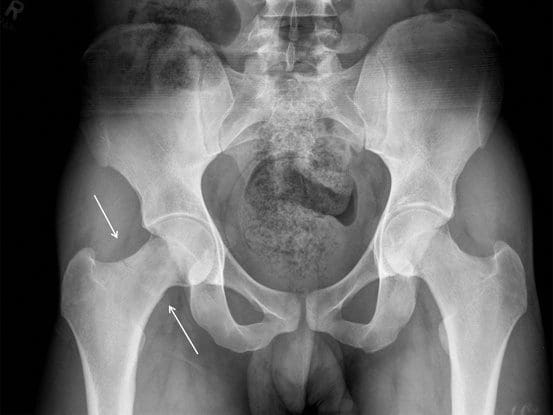The hip is a ball-and-socket joint composed of the head of the thigh bone, or femur, which acts as the ball and fits into the round socket of the hip bone, or acetabulum. The neck of the femur is located under the ball of the hip joint. Stress fractures to the femoral neck can entirely or partially detach the femoral head from the rest of the femur.
Femoral neck stress fractures can be either displaced, where the bone is transferred out of its normal position, or non-displaced, where the bone remains stable. These fractures may interrupt blood flow to the portion of the broken bone. In recovery, the blood supply prevents severely displaced femoral neck stress fractures from healing correctly.
Table of Contents
Causes and Symptoms of Femoral Neck Stress Fractures
Femoral neck stress fractures can result due to: a small slip-and-fall accident or twisting of the hip in older adults, osteoporosis, a high-impact injury, such as from an automobile accident, and sudden strenuous physical activity or changes in physical activity in younger individuals unaccustomed to the events, including from sports injuries.Â
The symptoms of femoral neck stress fractures generally include: pain and discomfort, radiating pain which extends to the knee, inability to bear weight on the affected lower extremity, shortening or sideways rotation of the leg, increased pain in the hip during the rotation of the leg, and inflammation on the side of the hip with the femoral neck stress fractures.
Diagnosis and Treatment of Femoral Neck Stress Fractures
A healthcare professional will diagnose femoral neck stress fractures based on the causes and symptoms of the health issue, followed by clinical evaluation. Many doctors order x-rays to diagnose femoral neck stress fractures. The doctor may also order magnetic resonance imaging, or MRI, and computer tomography, or CT, scanning for a better diagnosis.
Treatment for femoral neck stress fractures depends on the patient’s age as well as on the extent of the broken bone. Treatment for femoral neck stress fractures may include bed rest for several days followed by a physical rehabilitation program. A healthcare professional may prescribe drugs and/or medications to relieve pain, prevent blood clots and treat infection.
Many femoral neck stress fractures are treated through surgical interventions. Surgery for femoral neck stress fractures involves hip pinning if the bone is minimally displaced and the patient has enough bone density. The surgeon performs this by making a small incision and then inserting several screws to stabilize the bones which are broken.
Hip hemiarthroplasty or partial hip replacement is utilized for displaced fractures where the surgeon will replace the femoral head with a metal implant. The socket is not replaced in a partial hip replacement procedure. For total hip replacement, the surgeon will replace the socket of the hip joint, as well as the femoral head, with artificial metallic implants.

Femoral neck stress fractures are hip injuries which occur just below the femoral head, or the ball-and-socket hip joint. This area of the thigh bone, or femur, is known as the femoral neck. Femoral neck stress fractures happen when the ball is disconnected from the rest of the femur, or thigh bone. Treatment for this health issue includes rest and physical rehabilitation.
Dr. Alex Jimenez D.C., C.C.S.T.
Conclusion
Femoral neck stress fractures occur in the hip area below the ball-and-socket joint of the hip. A healthcare professional will suggest treatment based on the severity of the femoral neck stress fractures and the patient’s age. The scope of our information is limited to chiropractic as well as to spinal injuries and conditions. To discuss the subject matter, please feel free to ask Dr. Jimenez or contact us at 915-850-0900 .
Curated by Dr. Alex Jimenez

Additional Topics: Chiropractic for Athletes with Back Pain
Back pain is one of the most prevalent causes of disability and missed days at work worldwide. Back pain is the second most common reason for doctor office visits, outnumbered only by upper-respiratory infections. Approximately 80 percent of the population will experience back pain at least once throughout their life. The spine is a complex structure made up of bones, joints, ligaments, and muscles, among other soft tissues. Because of this, injuries and/or aggravated conditions, such as herniated discs, can eventually lead to symptoms of back pain. Sports injuries or automobile accident injuries are often the most frequent cause of back pain, however, sometimes the simplest of movements can have painful results. Fortunately, alternative treatment options, such as chiropractic care, can help ease back pain through the use of spinal adjustments and manual manipulations, ultimately improving pain relief.

EXTRA IMPORTANT TOPIC: Acetabular Hip Pain Treatment
Post Disclaimer
Professional Scope of Practice *
The information herein on "Femoral Neck Stress Fractures" is not intended to replace a one-on-one relationship with a qualified health care professional or licensed physician and is not medical advice. We encourage you to make healthcare decisions based on your research and partnership with a qualified healthcare professional.
Blog Information & Scope Discussions
Welcome to El Paso's Premier Wellness, Personal Injury Care Clinic & Wellness Blog, where Dr. Alex Jimenez, DC, FNP-C, a Multi-State board-certified Family Practice Nurse Practitioner (FNP-BC) and Chiropractor (DC), presents insights on how our multidisciplinary team is dedicated to holistic healing and personalized care. Our practice aligns with evidence-based treatment protocols inspired by integrative medicine principles, similar to those found on this site and our family practice-based chiromed.com site, focusing on restoring health naturally for patients of all ages.
Our areas of multidisciplinary practice include Wellness & Nutrition, Chronic Pain, Personal Injury, Auto Accident Care, Work Injuries, Back Injury, Low Back Pain, Neck Pain, Migraine Headaches, Sports Injuries, Severe Sciatica, Scoliosis, Complex Herniated Discs, Fibromyalgia, Chronic Pain, Complex Injuries, Stress Management, Functional Medicine Treatments, and in-scope care protocols.
Our information scope is multidisciplinary, focusing on musculoskeletal and physical medicine, wellness, contributing etiological viscerosomatic disturbances within clinical presentations, associated somato-visceral reflex clinical dynamics, subluxation complexes, sensitive health issues, and functional medicine articles, topics, and discussions.
We provide and present clinical collaboration with specialists from various disciplines. Each specialist is governed by their professional scope of practice and their jurisdiction of licensure. We use functional health & wellness protocols to treat and support care for musculoskeletal injuries or disorders.
Our videos, posts, topics, and insights address clinical matters and issues that are directly or indirectly related to our clinical scope of practice.
Our office has made a reasonable effort to provide supportive citations and has identified relevant research studies that support our posts. We provide copies of supporting research studies upon request to regulatory boards and the public.
We understand that we cover matters that require an additional explanation of how they may assist in a particular care plan or treatment protocol; therefore, to discuss the subject matter above further, please feel free to ask Dr. Alex Jimenez, DC, APRN, FNP-BC, or contact us at 915-850-0900.
We are here to help you and your family.
Blessings
Dr. Alex Jimenez DC, MSACP, APRN, FNP-BC*, CCST, IFMCP, CFMP, ATN
email: coach@elpasofunctionalmedicine.com
Multidisciplinary Licensing & Board Certifications:
Licensed as a Doctor of Chiropractic (DC) in Texas & New Mexico*
Texas DC License #: TX5807, Verified: TX5807
New Mexico DC License #: NM-DC2182, Verified: NM-DC2182
Multi-State Advanced Practice Registered Nurse (APRN*) in Texas & Multi-States
Multistate Compact APRN License by Endorsement (42 States)
Texas APRN License #: 1191402, Verified: 1191402 *
Florida APRN License #: 11043890, Verified: APRN11043890 *
License Verification Link: Nursys License Verifier
* Prescriptive Authority Authorized
ANCC FNP-BC: Board Certified Nurse Practitioner*
Compact Status: Multi-State License: Authorized to Practice in 40 States*
Graduate with Honors: ICHS: MSN-FNP (Family Nurse Practitioner Program)
Degree Granted. Master's in Family Practice MSN Diploma (Cum Laude)
Dr. Alex Jimenez, DC, APRN, FNP-BC*, CFMP, IFMCP, ATN, CCST
My Digital Business Card
RN: Registered Nurse
APRNP: Advanced Practice Registered Nurse
FNP: Family Practice Specialization
DC: Doctor of Chiropractic
CFMP: Certified Functional Medicine Provider
MSN-FNP: Master of Science in Family Practice Medicine
MSACP: Master of Science in Advanced Clinical Practice
IFMCP: Institute of Functional Medicine
CCST: Certified Chiropractic Spinal Trauma
ATN: Advanced Translational Neutrogenomics





 Again, We Welcome You.
Again, We Welcome You.
Comments are closed.